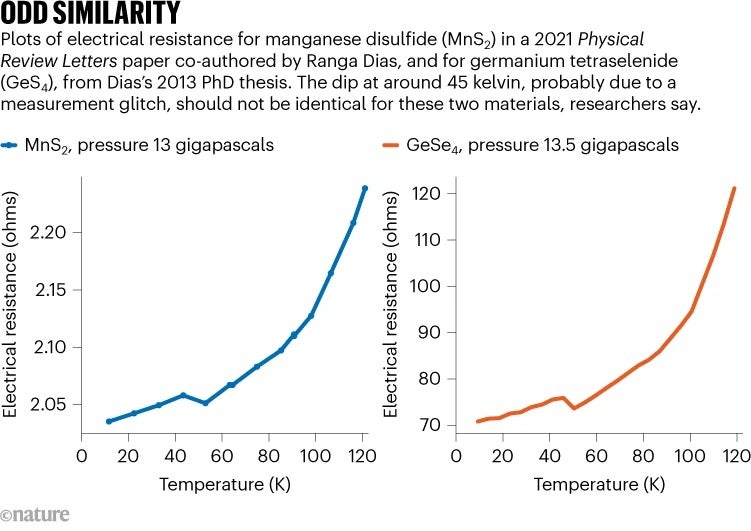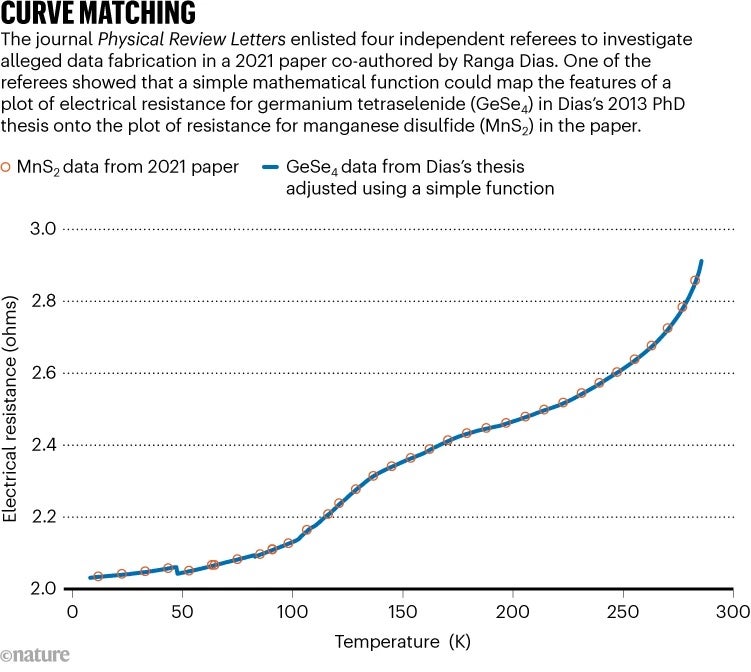A prominent journal has decided to retract a paper by Ranga Dias, a physicist at the University of Rochester in New York who has made controversial claims about discovering room-temperature superconductors — materials that would not require any cooling to conduct electricity with zero resistance. The forthcoming retraction, of a paper published by Physical Review Letters (PRL) in 2021, is significant because the Nature news team has learnt that it is the result of an investigation that found apparent data fabrication.
PRL’s decision follows allegations that Dias plagiarized substantial portions of his PhD thesis and a separate retraction of one of Dias’s papers on room-temperature superconductivity by Nature last September. (Nature’s news team is independent of its journals team.)
After receiving an e-mail last year expressing concern about possible data fabrication in Dias’s PRL paper — a study, not about room-temperature superconductivity, but about the electrical properties of manganese disulfide (MnS2) — the journal commissioned an investigation by four independent referees. Nature’s news team has obtained documents about the investigation, including e-mails and three reports of its outcome, from sources who have asked to remain anonymous. “The findings back up the allegations of data fabrication/falsification convincingly,” PRL’s editors wrote in an e-mail obtained by Nature. Jessica Thomas, an executive editor at the American Physical Society, which publishes PRL, declined to comment.
As part of the investigation, co-author Ashkan Salamat, a physicist at the University of Nevada, Las Vegas, and a long-time collaborator of Dias, supplied what he claimed was raw data used to create figures in the PRL paper. But all four investigators found that the data Salamat provided did not match the figures in the paper. Two of the referees wrote in their report that, the conclusions of their investigation “paint a very disturbing picture of apparent data fabrication followed by an attempt to hide or coverup [sic] the fact. We urge immediate retraction of the paper”.
Documents show that PRL agreed with the findings of the investigation, describing Salamat’s submission of “so-called raw data” as “what appears to be a deliberate attempt to obstruct the investigation”.
Salamat did not respond to multiple requests from Nature for comment by the time this story published. Dias responded to Nature’s requests for comment in a statement sent by a spokesperson. In it, he denies any misconduct and makes clear his commitment to room-temperature superconductivity research. “We remain certain that there has been no data fabrication, data manipulation or any other scientific misconduct in connection with our work,” the statement says. “Despite this setback, we remain enthusiastic about continuing our work.”
Heated debate
When Dias and his collaborators published a paper in Nature in October 2020 reporting that they had created a superconductor that worked at about 15 ºC under extreme pressure greater than one million atmospheres, they immediately made headlines. Most superconductors operate only at frigid temperatures below 200 kelvin (−73.15 ºC). Other researchers could not reproduce the results, and last year, Nature retracted the article. The retraction did not mention misconduct. Karl Ziemelis, chief physical sciences editor at the journal, explains that “data-processing irregularities” were discovered as a result of an investigation. “We lost confidence in the paper as a whole and duly retracted it. Our broader investigation of that work ceased at that point,” he says.
Earlier this year, Dias and his colleagues made an even more stunning claim, once again in Nature: a new material made of lutetium, hydrogen and nitrogen (Lu-H-N) could stay superconducting at room temperature and relatively low pressures. Finding a material that is a superconductor under ambient conditions has long been a goal of physicists: applications of an ambient superconductor include energy-efficient computer chips and powerful magnets for magnetic resonance imaging (MRI) machines. But because of the 2022 Nature retraction — and now the impending one in PRL — many physicists have been eyeing the Lu-H-N results with suspicion too.
Peter Armitage, a physicist at Johns Hopkins University in Baltimore, Maryland, who has been monitoring the controversy, says: “I just cannot see how we can trust anything [from Dias and Salamat] at this point.”
Asked about community trust in Dias’s research published by Nature, Ziemelis explains that each manuscript is evaluated independently, suggesting that the 2022 retraction had no bearing on the consideration of the paper published this year. “Our editors make decisions [about accepting manuscripts] based solely on whether research meets our criteria for publication,” he says. “If concerns are raised with us, we will always investigate them carefully.”
Allegations emerge
Issues with data in the 2021 PRL paper came to light late last year because James Hamlin, a physicist at the University of Florida in Gainesville, had noticed that text from his own 2007 PhD thesis appeared in Dias’s 2013 thesis. This prompted Hamlin to closely examine Dias’s work.
Scrolling through figures from Dias’s thesis, and comparing them with figures in recent papers by Dias, Hamlin noticed that a plot of the electrical resistance for the material germanium tetraselenide (GeSe4), discussed in Dias’s thesis, closely matched a plot of the resistance for MnS2, presented in the PRL paper. Both plots had an extremely similar curve, especially at low temperatures, he says (see ‘Odd similarity’). “It just seemed very hard to imagine that this could all be a coincidence.”

On 27 October 2022, Hamlin passed his concerns to PRL and all the authors of the paper. One of them, Simon Kimber, a physicist then at the University of Burgundy Franche-Comté in France, was immediately concerned and requested a retraction. “The moment I saw the comment, I knew something was wrong,” Kimber told Nature. “There is no physical explanation for the similarities between the data sets.” None of the other authors, besides Dias, responded to Nature’s requests for comment.
PRL asked the authors for a response to the concerns Hamlin had pointed out. Documents Nature obtained clarify what happened next. On 24 February this year, Salamat replied, defending the integrity of the data and claiming that other materials also exhibited similar behaviour. Kimber was unconvinced, however, and on 5 March, he wrote a reply to Salamat, noting that one feature in the GeSe4 plot, a dip in electrical resistance around 45 kelvin, seemed to be the result of a measurement glitch. The same dip appeared in the MnS2 plot, which should be impossible if the two were data from separate measurements.
Days later, PRL confirmed it was investigating the paper, and on 20 March, applied an ‘expression of concern’ to it online.
Investigating the data
After analysing the data, two of the four investigating referees concluded that the “only explanation of the similarity” in the GeSe4 and MnS2 plots is that data were taken from Dias’s 2013 thesis and used in the 2021 PRL paper. Another of the referees bolstered this conclusion in their own report by demonstrating how the alleged fabrication could have happened: the referee found a simple mathematical function that could be applied to the GeSe4 data to map it onto the MnS2 data (see ‘Curve matching’).

Nature discovered the identity of this anonymous referee, and reached out to them. “When you actually see the close agreement between the transformed GeSe4 dataset and the purported MnS2 data, it seems highly unlikely that this could be coincidental,” the referee told Nature.
For David Muller, a physicist at Cornell University in Ithaca, New York, the circumstances surrounding Dias’s retractions and thesis reminds him of a series of retractions made two decades ago, after researcher Jan Hendrik Schön at Bell Labs in Murray Hill, New Jersey, was discovered to have falsified data. In Schön’s case, and in his own experience, Muller says, “people who fake data tend not to do it just once”.
Disclosure: The author of this story is related to Robert Garisto, the managing editor of PRL. The two have had no contact about this story. Documents obtained by Nature show that Samindranath Mitra was the acting managing editor for PRL’s investigation.
This article is reproduced with permission and was first published on July 25, 2023.
